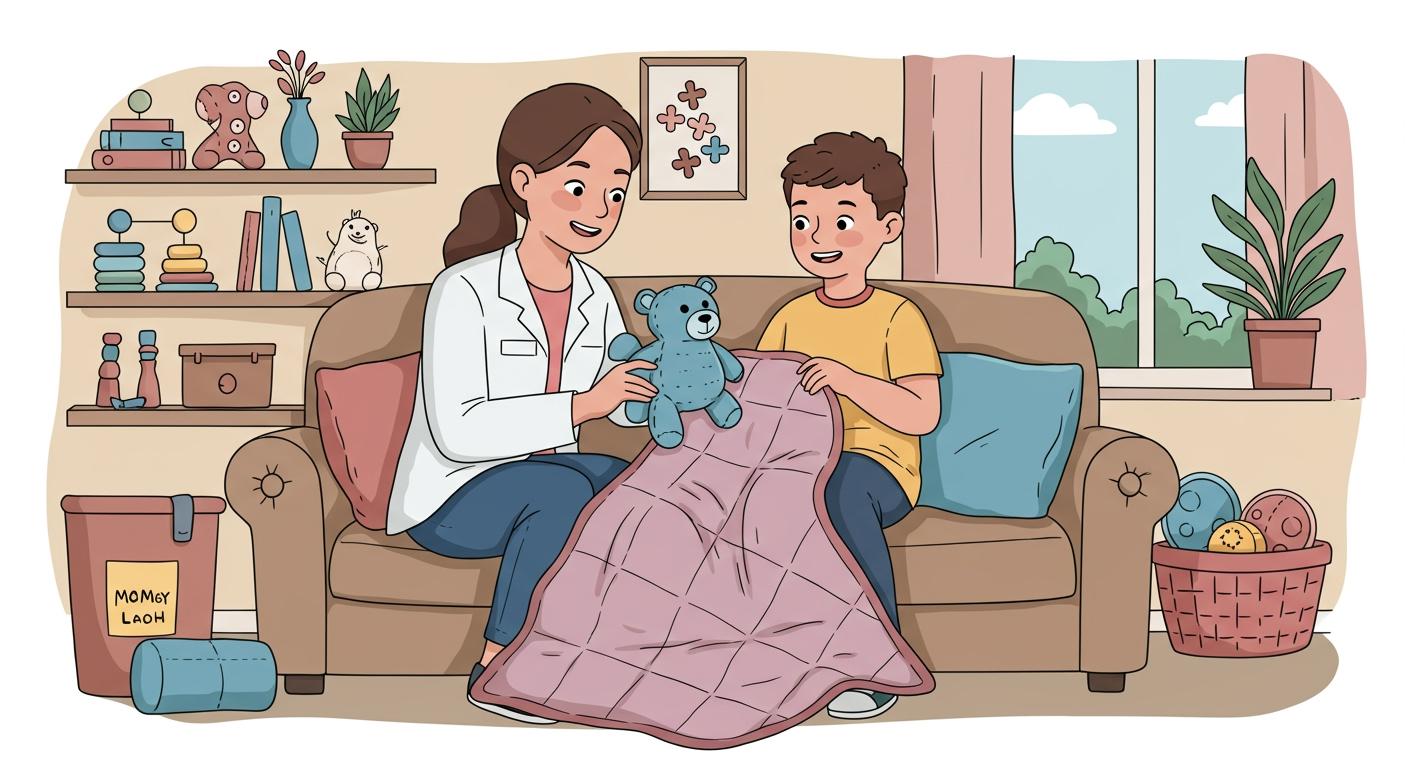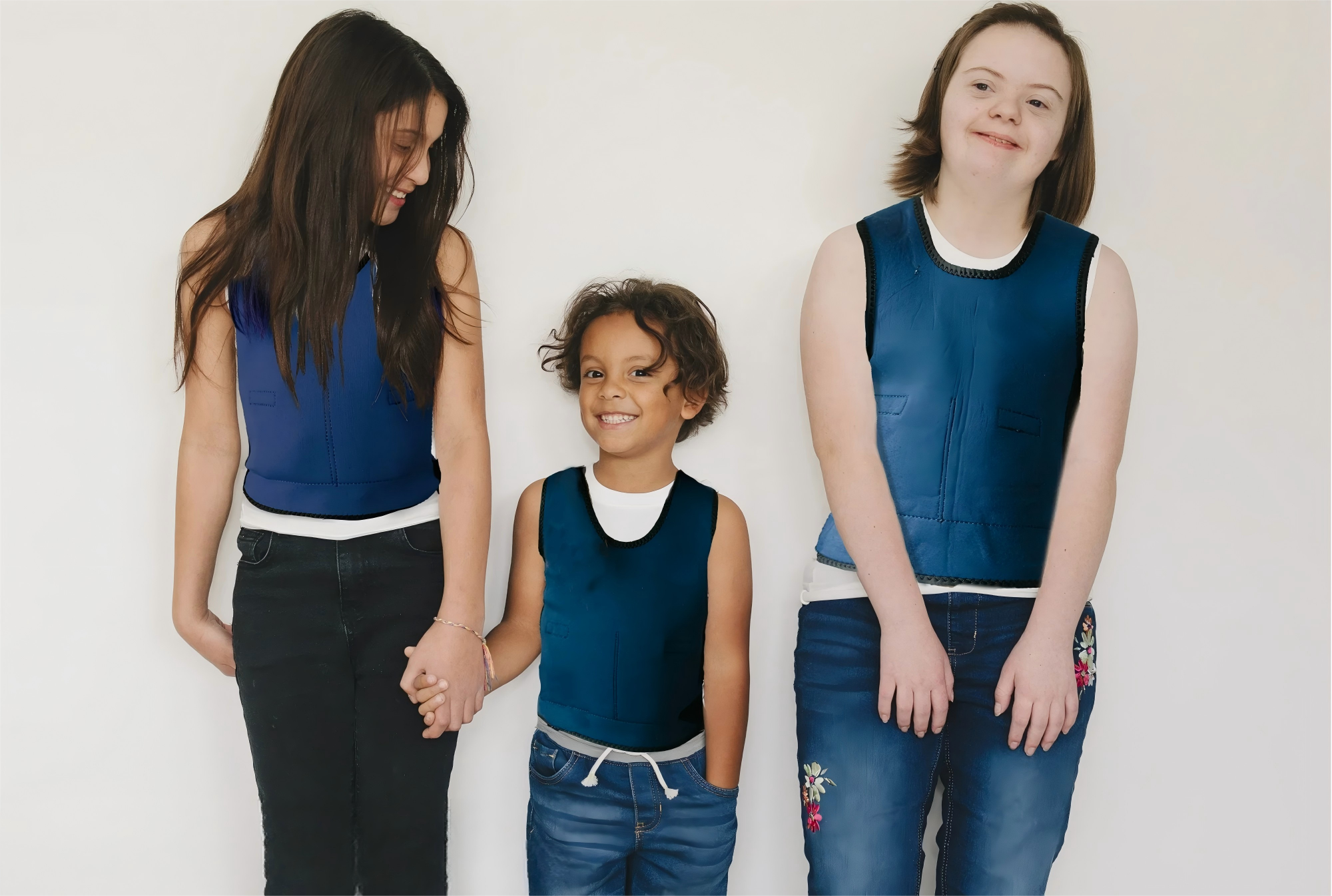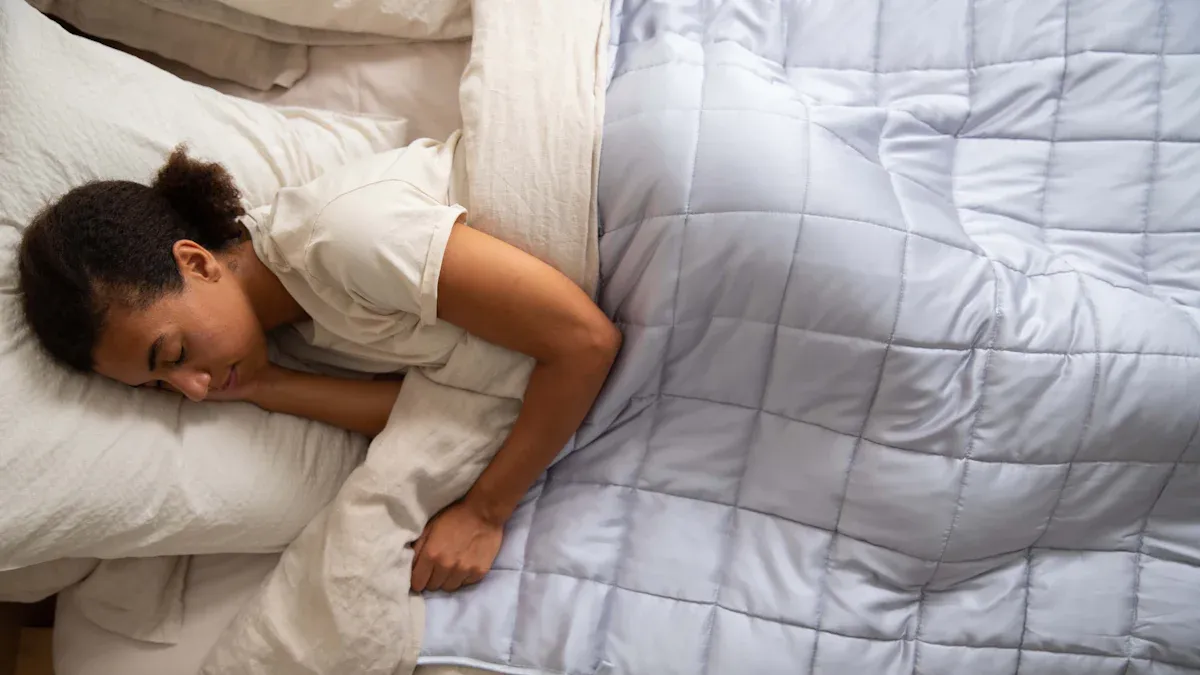Why Occupational Therapists Recommend Weighted Items for Sensory Regulation

You may see that many occupational therapists recommend weighted items for sensory regulation. These tools, like the Gravity Long Arm Weighted Doll, Weighted Gravity Blanket, and Weighted Compression Vest, give deep pressure input. This deep pressure helps you feel calm and pay attention. Many kids and adults have sensory challenges. Check the table below to see how often these problems happen:
Condition | Prevalence Rate |
|---|---|
SPD (children in the U.S.) | |
SPD (individuals with ASD) | 90% |
SPD (individuals with ADHD) | 50% - 64% |
Weighted items for sensory can really help you every day.
Key Takeaways
Weighted items give deep pressure that helps calm your body. They also help you focus better. These items are very helpful for people with sensory processing challenges.
Using weighted blankets or vests can lower anxiety. They help you feel safe in busy or loud places. The feeling is like getting a hug.
Pick weighted items that are about 10% of your body weight. This helps you get the right amount of deep pressure.
Always talk to an occupational therapist to find the best item for you. They can show you how to use it safely. They also help you avoid any problems.
Use weighted items in your daily routine for better sleep and relaxation. They can help you relax and get ready for sleep.
Weighted Items for Sensory Regulation

Deep Pressure and Sensory Input
Weighted items like blankets, vests, and lap pads help with sensory challenges. When you use them, you feel deep pressure on your body. This pressure feels like a soft hug or a tight squeeze. It helps your brain pay attention and makes you feel calm. Occupational therapists suggest weighted items for sensory because they help block out distractions and make you feel safe.
Weighted items give deep pressure touch, which helps you feel safe.
Deep pressure puts weight on your body and gives proprioceptive input that calms your nerves.
If you have tactile defensiveness, weighted items can help you feel more secure.
A weighted vest gives proprioceptive input like a big hug and calms your nerves.
You might see that deep pressure helps you relax and focus. Many therapists use weighted items to help people with sensory processing problems. These tools can help you feel less anxious and happier. The calming effect of deep pressure helps you control your senses and feel better in your space.
Tip: Try a weighted blanket or vest when you feel stressed. You might find it easier to focus and feel calm.
Scientific Evidence Table
| Evidence Type --- | Description --- | | Study Focus --- | Looks at how deep pressure helps with anxiety and stress. --- | | Findings --- | Deep pressure can lower anxiety and boost mood, especially for people with autism and ADHD. --- | | Methodology --- | People used weighted items and felt less anxious. --- |
Proprioceptive Benefits
Weighted items do more than give deep pressure. They also give your body proprioceptive input. Proprioception is knowing where your body is and how it moves. When you use weighted items, your body gets signals that help you know your place in space. This input helps you feel more organized and less stressed.
Weighted blankets give deep pressure touch, which helps your body make serotonin.
The parasympathetic nervous system slows your heart rate, lowers blood pressure, and drops cortisol.
Deep pressure touch helps people with autism control their senses and feel less anxious.
Weighted items for sensory help you handle too much sensory input. They help you feel safe and calm. You might sleep better and need less medicine. Weighted blankets and vests are good for calming your nerves and helping you feel steady.
Note: Always pick weighted items that fit your body and needs. Occupational therapists can help you choose the right one.
Benefits of Weighted Items

Calming and Focus
Weighted items help people with sensory processing problems in many ways. When you use a weighted vest or blanket, you feel deep pressure on your body. This pressure helps your body relax and lets your mind pay attention. Many kids with sensory issues use weighted items to stay calm in loud or busy places. You might feel less worried and focus better when you use these tools.
Weighted items help you feel calm by giving steady sensory input.
They help you control your feelings, so you can handle stress.
You might notice less worry and better focus, especially at school or in therapy.
Occupational therapists suggest weighted items because they help with sensory regulation. You can use them at home, in class, or during therapy. The benefits are feeling safer, more organized, and ready to learn.
Weighted Blankets for Autism
Weighted blankets for autism are popular for sensory regulation. Many therapists and caregivers see that kids with autism like the calming feeling from these blankets. Research shows weighted blankets for autism can lower anxiety and help you relax. In one study, 63% of kids felt less anxious after using a weighted blanket, and 78% liked it as a calming tool.
Weighted blankets for autism give deep pressure, which helps with sensory processing.
Many kids and parents say they feel happy and comfortable.
Weighted blankets for autism are often used with other sensory tools.
You might find that weighted blankets for autism help you feel safe and less bothered by sensory input.
Comfort and Sleep
A big benefit of weighted items is better sleep. Many kids with sensory problems have trouble sleeping. Weighted blankets can help you relax before bed. Studies show that while sleep time may not change much, kids and parents often feel more comfortable and think sleep is better.
Tip: Try a weighted blanket before bed to help your body relax and get ready for sleep.
Weighted items can make you feel cozy and safe. The benefits of weighted blankets are less worry, more comfort, and feeling secure. Even if studies are mixed, many families say sleep and mood get better.
Benefit | Description |
|---|---|
Calming | Helps lower anxiety and stress. |
Focus | Helps you pay attention and control your senses. |
Comfort | Makes you feel safe and helps with feelings. |
Sleep | Helps you sleep better and get ready for bed. |
Therapists and caregivers see these benefits all the time. They often suggest weighted items as part of a sensory support plan.
Safety and Limitations
When to Avoid Weighted Items
Weighted items can help, but sometimes you should not use them. Occupational therapists say to avoid weighted items if you have some health problems. If you have trouble breathing or with blood flow, talk to your doctor first. Some kids may not like how these tools feel. If you feel bad or upset, stop using the item right away.
Evidence Type | Description |
|---|---|
Medical Contraindications | If you have problems with blood flow or breathing, ask your doctor before using weighted items. |
Discomfort | Make sure the item feels good and does not make you upset. |
For little kids, always listen to what occupational therapists say. Never use weighted blankets for kids under two. This is because they could have trouble breathing.
Safe Use Tips
You can use weighted items safely if you follow some easy rules. Start with a blanket or vest that is about 10% of your weight. For kids, use the "10% rule" and ask a doctor for the best weight. Adults should think about their body size and what feels good.
Age Group | Recommended Weight Range | Additional Notes |
|---|---|---|
Children (3+ years) | 3 to 12 pounds | Should weigh at least 50 pounds; ask a doctor for advice. |
Adults | 10% of body weight | Change the weight for your body size; use less for smaller people. |
Always make sure you can take off the blanket or vest by yourself.
Only wear weighted vests for short times.
Watch for any signs that you feel bad or upset.
Do not use weighted items if you feel pain or cannot breathe well.
Ask a therapist or doctor if you are not sure what to do.
Tip: Weighted items work best when you feel safe and happy. Having someone watch you helps you stay safe and enjoy sensory regulation.
Evidence and Expert Insights
Research on Weighted Blankets
You might wonder how weighted blankets for autism help with sensory regulation. Many studies say these blankets can lower anxiety, especially for people who already feel worried. Weighted blankets give deep pressure input. This helps your body make serotonin. Serotonin helps you relax and control your feelings. Occupational therapists often say to use a blanket that is about 10% of your body weight. You may feel more comfortable and get used to the blanket’s feeling.
Here is a table that shows what research says about weighted blankets for autism:
| Findings --- | Implications --- | | Weighted blankets significantly reduce anxiety in individuals with higher baseline anxiety levels. --- | Suggests effectiveness in improving sensory regulation through deep pressure stimulation. --- | | No adverse effects reported from the use of weighted blankets. --- | Indicates safety as a non-invasive intervention. --- | | Gaps remain regarding optimal intervention duration and long-term effects. --- | Highlights the need for further research to establish definitive conclusions. --- |
Weighted blankets for autism can also help you sleep better and feel good. Many therapists notice a calming effect on the proprioceptive system. You should start using the blanket slowly to get used to it. Weighted blankets can help you sleep and feel more relaxed.
Occupational Therapist Recommendations
Occupational therapists read many studies before they suggest weighted blankets for autism or other weighted items. The research does not always agree. Some studies say weighted vests help you pay attention and lower self-stimulatory behaviors. Other studies say weighted vests do not help kids with autism learn better.
You can look at these expert opinions:
Some evidence shows weighted items may help you focus and do daily tasks if you have autism or ADHD.
A little evidence says weighted items can lower behaviors like aggression, but they do not make positive behaviors happen more.
The American Journal of Occupational Therapy says therapists should not use weighted vests for kids with sensory challenges.
The best way is to use weighted items as part of a sensory plan with help from a professional.
Long-term studies show weighted blankets for autism may help kids with ADHD sleep better. You should always work with therapists to find the best tools for you.
Choosing and Using Weighted Items
Selecting the Right Weighted Item
When you choose a weighted item, you want to make sure it fits your needs. You should look at several factors before you decide. The right item can help you feel calm and comfortable, especially if you have sensory challenges. Here are some things to consider:
Weight: Pick an item that weighs about 10% of your body weight. This helps you get the right amount of deep pressure.
Size: Make sure the item covers you comfortably. It should not be too small or too big.
Fabric: Choose a material that feels soft and lasts a long time. You want it to be gentle on your skin.
Fill: The inside can be plastic pellets or glass beads. Each type feels different and changes how warm the item gets.
Weight Distribution: Look for items with evenly spread pockets. This gives you steady pressure all over.
If you use weighted blankets for autism, you want to check these features. The right blanket can help you relax and sleep better. Many parents say their children feel calmer during therapy or rest when they use weighted blankets for autism.
Tips for Parents and Caregivers
You can help your child get the most out of weighted items at home or school. Teachers and caregivers use many strategies to support children with sensory needs. Here is a table with ideas you can try in the classroom:
| Strategy --- | Description --- | | Weighted Lap Pad --- | Use during school hours with OT recommendation and teacher approval. --- | | Weighted Stuffed Animal --- | Provides comfort and sensory input. --- | | Sensory Bins --- | Include materials like rice, beans, or water beads for tactile exploration. --- | | Cozy Corner --- | Create a space with soft pillows or bean bags for sensory breaks. --- | | Deep Breathing Visuals --- | Use guides to help students relax. --- | | Quiet Fidgets --- | Provide stress balls or calming jars for self-regulation. --- | | Mindfulness Techniques --- | Integrate guided imagery or deep breathing exercises. --- | | Quiet Activities --- | Allow time for reading or drawing to help students reset. --- | | Deep Pressure Input --- | Let students carry books or push carts. --- | | Resistance Bands --- | Attach to chair legs for leg movement. --- | | Therapy Balls --- | Use for seated bouncing or stretching. --- | | Physical Activities --- | Encourage wall push-ups or classroom chores. --- |
Tip: Start with short sessions when you introduce weighted blankets for autism. Watch how your child reacts and adjust the time as needed.
Parents often notice that weighted items like blankets and vests help their children feel calm. You may see benefits during therapy or rest periods. If you use weighted blankets for autism, you can help your child relax and feel safe. Always talk to your occupational therapist before you try new items.
Weighted items can help you with sensory challenges. They give deep pressure that calms your body and helps you focus better.
Category | |
|---|---|
Regulation of the Sensory System | Makes you less sensitive and helps you know where your body is |
Calming and Focusing Effects | Helps you feel less anxious, pay attention, and sleep better |
Motor Skills Support | Helps you move and plan actions |
You should talk to a professional to find what works for you. Weighted items are just one part of your support plan.
FAQ
How do you know if a weighted item is right for you?
You should talk to your occupational therapist. You may notice you feel calmer or more focused when using weighted items. If you feel uncomfortable or upset, stop using the item and ask for advice.
Can you use weighted items all day?
You should not use weighted items all day. Most therapists suggest short sessions, like 20 to 30 minutes at a time. Always take breaks and watch how your body feels.
Are weighted blankets safe for young children?
Weighted blankets are not safe for children under two years old. Always follow safety guidelines and check with your doctor before using a weighted blanket for your child.
What should you do if you feel uncomfortable with a weighted item?
Remove the item right away.
Tell an adult or your therapist.
Try a lighter weight or a different item next time.
Do weighted items replace other therapies?
Weighted items do not replace other therapies. You should use them as part of your sensory support plan. Always work with your therapist to find what works best for you.
See Also
Sensory Weighted Toys Designed for Children with Challenges
Choosing the Ideal Weighted Vest for Sensory Comfort
Effective Therapies Addressing Sensory Challenges in Autism
